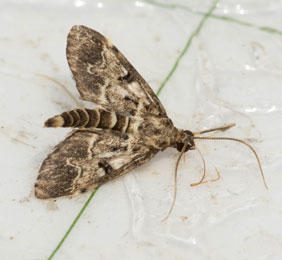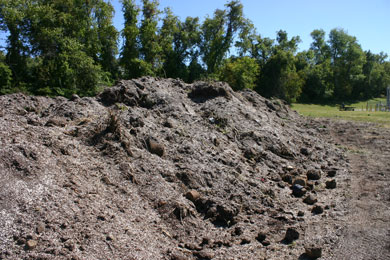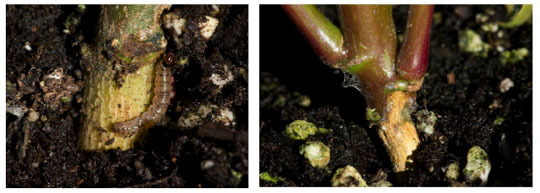10/29/2013
Another Invasive Species in Maryland: The European Pepper Moth
Stanton Gill

An unexpected gift from Europe is being spread around rapidly in America. In the summer of 2013, a grower submitted a caterpillar for identification that was damaging several species of greenhouse plants. The caterpillar was the European pepper moth (EPM),
Duponchelia fovealis, native to several countries in Europe. This pest is being spread from state to state, first showing up in key greenhouse states such as Florida and California, and has now been confirmed in two Maryland greenhouse operations. Greenhouse managers and Extension people working with greenhouse growers should be alert and monitor for this new pest. How much economic damage the European pepper moth might cause in the United States is still unknown, but we do know that this pest is being detected in many states in greenhouse operations. In Maryland, we know it damages geraniums and girdles the stems of poinsettias.
Figure 1: The adult European pepper moths have bodies half the length of a penny. The wings have distinct white wavy patterns on the wings.
Since this pest has rapidly spread across the United States and Canada, traditional containment through quarantine has been discarded as impractical. In 2011, extensive monitoring was conducted in several counties in Georgia and Florida. The European pepper moth has been found infesting lantana plants in a greenhouse in Georgia. While EPM was found in greenhouses in those states, it has not been found in field production of fruits or vegetables.
It might be that the insect is adapted to the close growing conditions in a greenhouse environment and not suited for most field production situations. In greenhouse environments, the foliage touching the substrate surface may make ideal conditions for this moisture-loving pest. The moth is native to both freshwater and saltwater marshlands of southern Europe, the eastern Mediterranean region, the Canary Islands, Syria and Algeria. The larvae of this moth have been recorded on more than 70 host species in a wide range of plants families.
In the United States, the moth was first detected on begonias in San Diego County, California, in 2004. This population was eradicated. In 2010, it showed up again in San Diego County. By September 2011, it had been detected in 17 counties in California. In an email from an entomologist in California, the EPM has spread to several additional counties in California. It also has been detected in Alabama, Arizona, Colorado, Florida, Georgia, Kentucky, Mississippi, New York (including Long island), North Carolina, Oklahoma, Oregon, South Carolina, Tennessee, Texas and Washington State. European pepper moth has been recorded as a problem in greenhouse-grown chrysanthemums and other cut flower species in Ontario. It is not known whether this pest is mainly a greenhouse problem or whether it could cause damage in field and landscape plantings.
In June 2013, European pepper moth larvae were found infesting zonal geraniums and petunias in Central Maryland in a commercial greenhouse. Two alert greenhouse managers found the caterpillars boring in the base stems of plants and submitted samples to our University of Maryland Central Maryland Research and Education lab. We identified the caterpillars with help from Lance Osborne, who is an entomologist at University of Florida and USDA-ARS. A Maryland Department of Agriculture taxonomist, Gaye Williams, has subsequently confirmed our identification of this pest.
Figu re 2: European pepper moth may also overwinter in these discard plant piles since the decomposing plant material creates a little warmer micro-environment, so they need to be properly monitored.
re 2: European pepper moth may also overwinter in these discard plant piles since the decomposing plant material creates a little warmer micro-environment, so they need to be properly monitored.
Damage
In Maryland, we’ve found the caterpillars boring into geranium stems at the base of the plant. On petunias, they were mainly feeding on leaves close to the substrate surface, but there was some girdling damage at the base of the plant. We’ve detected them feeding on foliage of chrysanthemums, but none were found girdling the stems. On poinsettia crops, we found the larvae will use partially decomposed leaves to cover their body while they feed on the stems of poinsettias. This makes detection difficult and growers will have to probe away the foliage to expose the larvae. The larvae does not like exposure to light and will thrash around when exposed. The larvae do put out silk from their mouth, so the silk on the stems is easier to monitor for when examining plants.
Monitoring for EPM
The adults fly at night, but if you disturb plants during the day, they’ll fly up, flying in evasive patterns and travel a short distance before they alight again. At night, the moths have been reported to travel greater distances. The adults are small moths with bodies half the length of a penny. The moth, when sitting on surfaces, typically project their abdomen up in the air creating a c-shaped body. The wings have distinct white wavy patterns on the wings. (See Figure 1.)
There are pheromone traps available from biological supply houses. We found pheromone for baiting traps available from Koppert and Syngenta. Hang the traps in the greenhouse over the poinsettia crop this fall. In spring, hang the traps over general bedding plants. The traps will not trap-out a population, but are an effective monitoring tool.
Most greenhouse operations have a discard plant pile somewhere behind the greenhouse. In Maryland, we found the discard pile served as the epi-center for the EPM. The insect may also overwinter in these discard plant piles since the decomposing plant material creates a little warmer micro-environment. Be sure to monitor the discard pile at the greenhouse operation. (See Figure 2.)
When examining plants, look for wilting plants. Often the larvae will put out silk from their mouth and place it on the stem near the soil line. This visual clue is something to investigate. The larvae camouflage their body with decomposing leaves as they feed on the stems. The decomposing leaves may need to be probed off to expose the larvae.

Left: The larvae of the European pepper moth feeding on a poinsettia causing girdling.
Right: As the European pepper moth larvae prepare to pupate, they web silk together, usually on foliage close to the soil.
What damage is caused by the larvae?
The eggs are laid on foliage and hatching larvae of EPM initially feed on lower leaves near the soil level, making round or crescent-shaped holes. This is damage that can be monitored visually in an IPM scouting program. Older larvae consume whole leaves or they can feed on roots or at the base of the plant at the soil level. In some cases they girdle the base of a plant. With some vegetables and fruits, the larvae bore into the fruit. Later, instar larvae burrow into soft woody or herbaceous stems causing damage in which fungi can enter. In the zonal geraniums brought into our lab, the stems had visible holes and this is what workers first detected. On poinsettia crops, we found them girdling the stems at the soil level. As the larvae prepare to pupate, they web silk together, usually on foliage close to the soil.
Plant hosts for the European pepper moth
European pepper moth has a wide host range. The plant host list below is not all-inclusive. It focuses on plants most likely to be found in nurseries, greenhouses and home gardens in Maryland.
Amaranthus
Anemone
Annona
Anthurium
Bacopa lanigera (water hyssop)
Begonia tuberosa
Begonia elatior
Bellis perennis (English daisy)
Beta vulgairis (beets)
Capsicum annuum (pepper)
Chrysanthemum
Cineraria
Coleus
Cucumis (cucumbers)
Cyclamen
Euphorbia pulcherrima (poinsettia)
Eusotma grandiflorum (lisianthus)
Ficus triangularis (fig)
Fragaria (strawberries)
Gerbera (African daisies)
Heuchera (coral bells)
Impatiens
Kalanchoe
Lactuca (lettuce)
Limonium (sea lavender)
Lysimachia
Malva sylvestris (mallow)
Ocimum basilicum (basil)
Origanum majorana (majorum)
Oxalis acetosella (common wood sorrel)
Pelargonium (geranium)
Phalaenopsis (orchid)
Rhododendron (azalea)
Rosa (rose)
Rubus fruticosus (blackberry)
Senecio
Solanum lycopersicum (tomato)
Thymus (thyme)
Zea (corn)
Life cycle
The moth is active at night and lays white eggs in small clusters on the undersides of foliage, usually close to a main vein. Eggs have been recorded on stems and on the tops of leaves, but usually are found on undersides of foliage. The egg clusters are in groups of three to 10 and are usually laid in overlapping patterns. The eggs turn pink, then red as the embryo develops and end up brown colored just before hatching. The larvae have a dark-colored head capsule and a dark colored hardened dorsal plate just behind the head. On segments just behind the head, there are two rows of transverse spots. There’s at least one stout hair sticking out of each spot. The larvae feed mainly at night and avoid light. When we placed live larvae under a dissecting microscope with a light source they were actively trying to move out of the lit area. As the larvae grow their body color changes from a creamy white to a dirty brown color. The larvae lose their spots just before pupation. The length of development depends on temperature, but in a greenhouse at 68F (20C) the egg stage is 4 to 9 days, the larval stage is 3 to 4 weeks, 1 to 2 weeks for pupation and adults for 1 to 2 weeks. Females mate soon after emerging. The males and females are strong fliers and have been recorded to fly several miles. Strong flight is at night. In the day, adults fly up and travel short distances.
Controlling an infestation
Cultural control: Removing debris and lower leaves will reduce habitat for the larvae. The problem is that most plants grown in greenhouses are grown to have leaves all of the way down to the soil level. If this moth becomes established in the greenhouse, then making the effort to remove lower foliage will help reduce larval populations.
Plant discard piles should be turned regularly so the other plant material is turned into the center of the pile to improve the composting process. With good composting practices, the plant material will reach temperatures of 150 to 170F (65 to 76C), killing any larvae and adults. Some growers have used black light electric zappers to kill adults flying at night.
Chemical and biological control: Fortunately, this caterpillar is susceptible to several classes of pesticides. Young larvae feeding on foliage are fairly easy to hit with pesticides. Older larvae, which bore into stems or fruit, are less accessible to insecticides and, therefore, are more difficult to control. Repeated sprays of Bacillus thuringiensis can be directed to foliage to kill larvae feeding on the foliage. At least three applications at seven-day intervals are suggested. Spinosad materials should also be effective in controlling the caterpillars, but making contact on the undersides of foliage where larvae feed will be challenging. Acephate was effective in our Maryland trials, but it may cause phototoxicity on some plants, such as poinsettia.
We are interested in hearing if other greenhouse operations are having problems with this pest. Please contact me at
Sgill@umd.edu.
GT
References:
Stanton Gill is Extension Specialist in IPM for Greenhouses and Nurseries for the University of Maryland Extension.